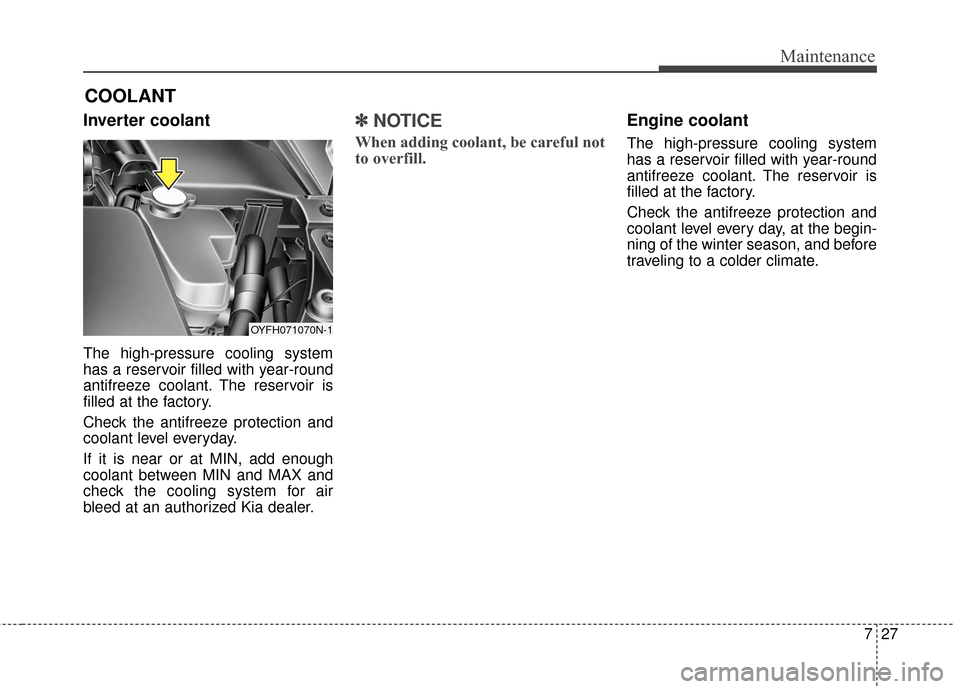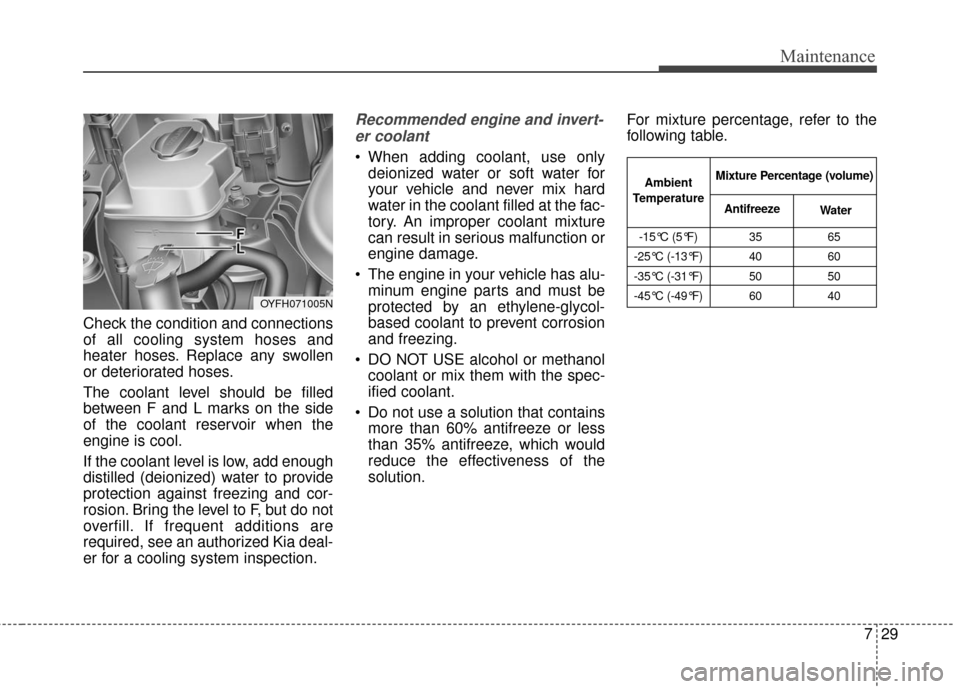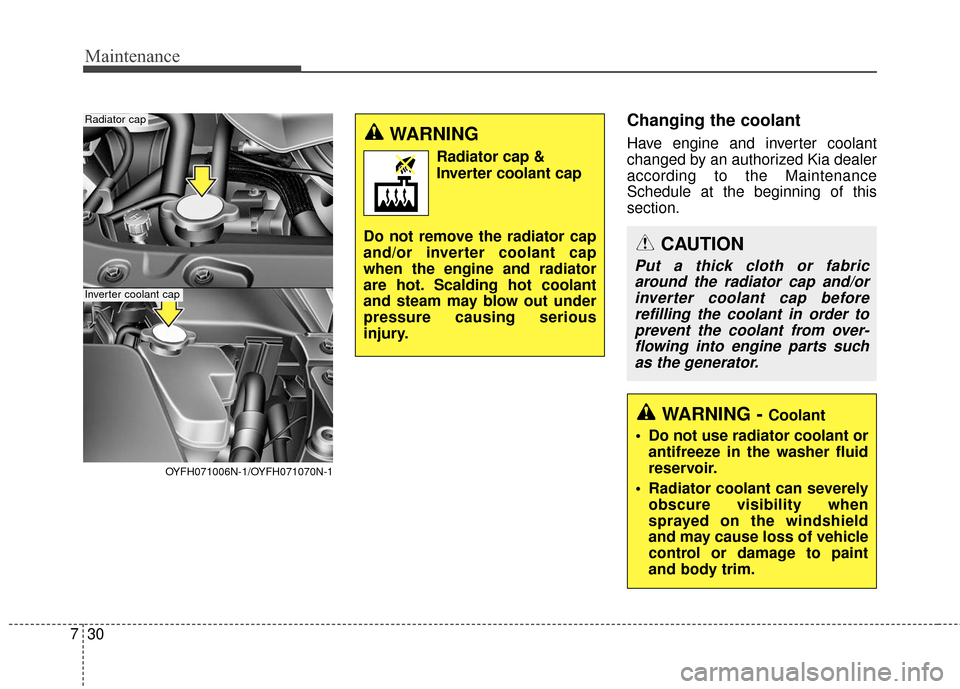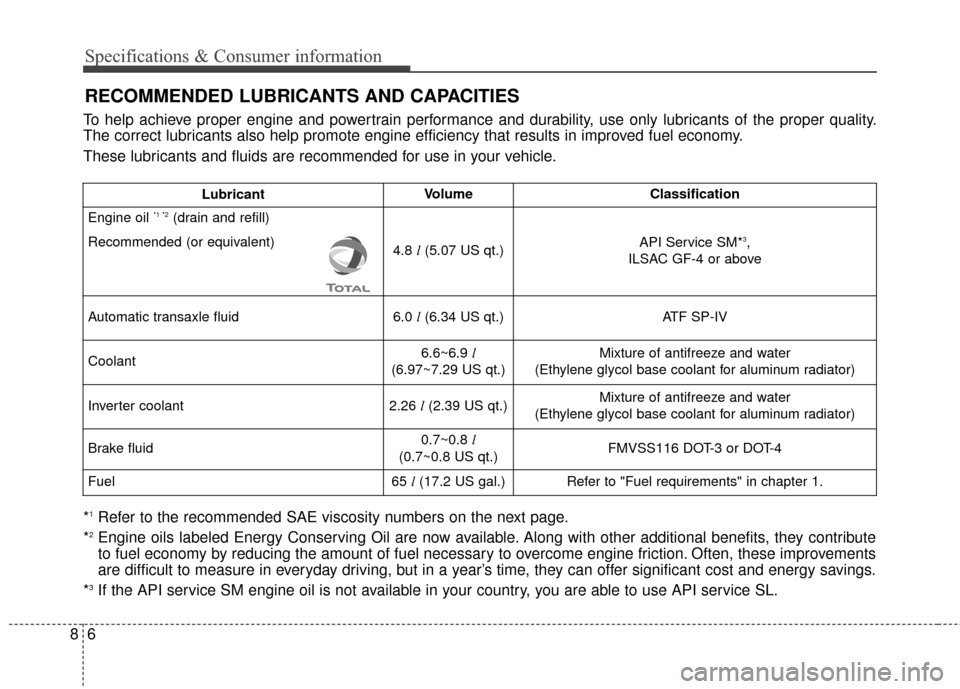2016 KIA Optima Hybrid engine coolant
[x] Cancel search: engine coolantPage 367 of 466

727
Maintenance
COOLANT
Inverter coolant
The high-pressure cooling system
has a reservoir filled with year-round
antifreeze coolant. The reservoir is
filled at the factory.
Check the antifreeze protection and
coolant level everyday.
If it is near or at MIN, add enough
coolant between MIN and MAX and
check the cooling system for air
bleed at an authorized Kia dealer.
✽ ✽NOTICE
When adding coolant, be careful not
to overfill.
Engine coolant
The high-pressure cooling system
has a reservoir filled with year-round
antifreeze coolant. The reservoir is
filled at the factory.
Check the antifreeze protection and
coolant level every day, at the begin-
ning of the winter season, and before
traveling to a colder climate.
OYFH071070N-1
Page 368 of 466

Maintenance
28
7
Checking the coolant level✽
✽
NOTICE
The engine coolant and/or inverter
coolant level is influenced by hybrid
system temperature. Before filling
the engine coolant and/or inverter
coolant, turn the hybrid vehicle off,
fill the engine coolant and/or invert-
er coolant carefully.
Turn the engine off and wait until it
cools down. Use extreme care when
removing the radiator cap. Wrap a
thick towel around it, and turn it
counterclockwise slowly to the first
stop. Step back while the pressure is
released from the cooling system.
When you are sure all the pressure
has been released, press down on
the cap, using a thick towel, and con-
tinue turning counterclockwise to
remove it.
WARNING
Radiator / Inverter
cap
Do not remove the radiator or
the inverter cap when the
engine is hot. Scalding hot
coolant and steam may blow
out under pressure.
WARNING
Cooling fan
Use caution when working near
the blade of the cooling fan. The
electric motor (cooling fan) is
controlled by engine coolant
temperature, refrigerant pres-
sure and vehicle speed. It will
sometimes operate when the
engine is not running.
CAUTION - Radiator / Inverter cap
Never attempt to remove theradiator or inverter cap whilethe engine is operating or hot.Doing so might lead to coolingsystem and engine damage.
Page 369 of 466

729
Maintenance
Check the condition and connections
of all cooling system hoses and
heater hoses. Replace any swollen
or deteriorated hoses.
The coolant level should be filled
between F and L marks on the side
of the coolant reservoir when the
engine is cool.
If the coolant level is low, add enough
distilled (deionized) water to provide
protection against freezing and cor-
rosion. Bring the level to F, but do not
overfill. If frequent additions are
required, see an authorized Kia deal-
er for a cooling system inspection.
Recommended engine and invert-er coolant
When adding coolant, use only deionized water or soft water for
your vehicle and never mix hard
water in the coolant filled at the fac-
tory. An improper coolant mixture
can result in serious malfunction or
engine damage.
The engine in your vehicle has alu- minum engine parts and must be
protected by an ethylene-glycol-
based coolant to prevent corrosion
and freezing.
DO NOT USE alcohol or methanol coolant or mix them with the spec-
ified coolant.
Do not use a solution that contains more than 60% antifreeze or less
than 35% antifreeze, which would
reduce the effectiveness of the
solution. For mixture percentage, refer to the
following table.
-15°C (5°F) 35
65
-25°C (-13°F) 40 60
-35°C (-31°F) 50 50
-45°C (-49°F) 60 40
Ambient
Temperature Mixture Percentage (volume)
Antifreeze Water
OYFH071005N
Page 370 of 466

Maintenance
30
7
Changing the coolant
Have engine and inverter coolant
changed by an authorized Kia dealer
according to the Maintenance
Schedule at the beginning of this
section.
WARNING - Coolant
Do not use radiator coolant or antifreeze in the washer fluid
reservoir.
Radiator coolant can severely obscure visibility when
sprayed on the windshield
and may cause loss of vehicle
control or damage to paint
and body trim.
CAUTION
Put a thick cloth or fabricaround the radiator cap and/orinverter coolant cap beforerefilling the coolant in order toprevent the coolant from over-flowing into engine parts suchas the generator.
OYFH071006N-1/OYFH071070N-1
Radiator cap
Inverter coolant cap
WARNING
Radiator cap &
Inverter coolant cap
Do not remove the radiator cap
and/or inverter coolant cap
when the engine and radiator
are hot. Scalding hot coolant
and steam may blow out under
pressure causing serious
injury.
Page 430 of 466

Canister
Fuel vapors generated inside the fuel
tank are absorbed and stored in the
onboard canister. When the engine is
running, the fuel vapors absorbed in
the canister are drawn into the surge
tank through the purge control sole-
noid valve.
Purge Control Solenoid Valve(PCSV)
The purge control solenoid valve is
controlled by the Engine Control
Module (ECM); when the engine
coolant temperature is low during
idling, the PCSV closes so that evap-
orated fuel is not taken into the
engine. After the engine warms up
during ordinary driving, the PCSV
opens to introduce evaporated fuel to
the engine.
3. Exhaust emission control system
The Exhaust Emission Control
System is a highly effective system
which controls exhaust emissions
while maintaining good vehicle per-
formance.
Vehicle modifications
This vehicle should not be modified.
Modification of your vehicle could
affect its performance, safety or
durability and may even violate gov-
ernmental safety and emissions reg-
ulations.
In addition, damage or performance
problems resulting from any modifi-
cation may not be covered under
warranty.
If you use unauthorized electronic
devices, it may cause the vehicle to
operate abnormally, wire damage,
battery discharge and fire. For your
safety, do not use unauthorized
electronic devices.
Engine exhaust gas precautions
(carbon monoxide)
Carbon monoxide can be present with other exhaust fumes.
Therefore, if you smell exhaust
fumes of any kind inside your vehi-
cle, have it inspected and repaired
immediately. If you ever suspect
exhaust fumes are coming into
your vehicle, drive it only with all
the windows fully open. Have your
vehicle checked and repaired
immediately.
WARNING - Exhaust
Engine exhaust gases contain
carbon monoxide (CO). Though
colorless and odorless, it is
dangerous and could be lethal if
inhaled. Follow the instructions
on this page to avoid CO poi-
soning.
790
Maintenance
Page 437 of 466

68
Specifications & Consumer information
RECOMMENDED LUBRICANTS AND CAPACITIES
To help achieve proper engine and powertrain performance and durability, use only lubricants of the proper quality.
The correct lubricants also help promote engine efficiency that results in improved fuel economy.
These lubricants and fluids are recommended for use in your vehicle.
*1Refer to the recommended SAE viscosity numbers on the next page.
*2Engine oils labeled Energy Conserving Oil are now available. Along with other additional benefits, they contribute
to fuel economy by reducing the amount of fuel necessary to overcome engine friction. Often, these improvements
are difficult to measure in everyday driving, but in a year’s time, they can offer significant cost and energy savings.
*
3If the API service SM engine oil is not available in your country, you are able to use API service SL.
LubricantVolumeClassification
Engine oil *1 *2 (drain and refill)
Recommended (or equivalent)
4.8 l(5.07 US qt.)API Service SM*3,
ILSAC GF-4 or above
Automatic transaxle fluid6.0 l(6.34 US qt.)ATF SP-IV
Coolant 6.6~6.9 l
(6.97~7.29 US qt.)Mixture of antifreeze and water
(Ethylene glycol base coolant for aluminum radiator)
Inverter coolant2.26 l(2.39 US qt.)Mixture of antifreeze and water
(Ethylene glycol base coolant for aluminum radiator)
Brake fluid0.7~0.8 l
(0.7~0.8 US qt.)FMVSS116 DOT-3 or DOT-4
Fuel65 l(17.2 US gal.)Refer to "Fuel requirements" in chapter 1.
Page 460 of 466

I3
Index
BSD (Blind Spot Detection) /LCA (Lane Change Assist) . . . . . . . . . . . . . . . . . . 5-37
Non-operating condition . . . . . . . . . . . . . . . . . . . . . 5-41
RCTA (Rear cross traffic alert) . . . . . . . . . . . . . . . . 5-39
Brake fluid . . . . . . . . . . . . . . . . . . . . . . . . . . . . . . . . . . 7-31\
Checking the brake fluid level . . . . . . . . . . . . . . . . . 7-31
Brake system. . . . . . . . . . . . . . . . . . . . . . . . . . . . . . . . . 5-17 Anti-lock brake system (ABS) . . . . . . . . . . . . . . . . . 5-21
Electronic stability control (ESC) . . . . . . . . . . . . . . 5-23
Good braking practices . . . . . . . . . . . . . . . . . . . . . . 5-29
Hill-start assist control (HAC) . . . . . . . . . . . . . . . . . 5-27
Parking brake . . . . . . . . . . . . . . . . . . . . . . . . . . . . . . 5-19
Power brakes . . . . . . . . . . . . . . . . . . . . . . . . . . . . . . 5-17
Vehicle stability management (VSM) . . . . . . . . . . . 5-27
Bulb wattage . . . . . . . . . . . . . . . . . . . . . . . . . . . . . . . . . . 8-4
Child restraint system . . . . . . . . . . . . . . . . . . . . . . . . . . 3-28 Lower anchor system . . . . . . . . . . . . . . . . . . . . . . . . 3-33
Tether anchorage system . . . . . . . . . . . . . . . . . . . . . 3-32
Using a child restraint system . . . . . . . . . . . . . . . . . 3-29
Climate control air filter . . . . . . . . . . . . . . . . . . . . . . . . 7-36 Filter inspection . . . . . . . . . . . . . . . . . . . . . . . . . . . . 7-36
Filter replacement. . . . . . . . . . . . . . . . . . . . . . . . . . . 7-36
Coolant . . . . . . . . . . . . . . . . . . . . . . . . . . . . . . . . . . . . \
. 7-27 Changing the coolant . . . . . . . . . . . . . . . . . . . . . . . . 7-30
Engine coolant . . . . . . . . . . . . . . . . . . . . . . . . . . . . . 7-27 Inverter coolant. . . . . . . . . . . . . . . . . . . . . . . . . . . . . 7-27
Cruise Control system . . . . . . . . . . . . . . . . . . . . . . . . . 5-31 To cancel cruise control . . . . . . . . . . . . . . . . . . . . . . 5-33
To decrease the cruising speed . . . . . . . . . . . . . . . . . 5-32
To increase cruise control set speed . . . . . . . . . . . . . 5-32
To resume cruising speed at more than approximately25 mph (40 km/h) . . . . . . . . . . . . . . . . . . . . . . . . . 5-34
To set cruise control speed . . . . . . . . . . . . . . . . . . . . 5-31
To temporarily accelerate with the cruise control on . . 5-33
To turn cruise control off . . . . . . . . . . . . . . . . . . . . . 5-34
Defroster . . . . . . . . . . . . . . . . . . . . . . . . . . . . . . . . . . . . \
4-99 Rear window defroster . . . . . . . . . . . . . . . . . . . . . . . 4-99
Dimensions . . . . . . . . . . . . . . . . . . . . . . . . . . . . . . . . . . . 8-\
2
Door locks. . . . . . . . . . . . . . . . . . . . . . . . . . . . . . . . . . . 4-\
14 Auto door lock/unlock feature . . . . . . . . . . . . . . . . . 4-16
Child-protector rear door lock . . . . . . . . . . . . . . . . . 4-16
Impact sensing door unlock system . . . . . . . . . . . . . 4-16
Operating door locks from inside the vehicle . . . . . 4-14
Operating door locks from outside the vehicle . . . . 4-14
Driver position memory system . . . . . . . . . . . . . . . . . . 4-35 Easy access function . . . . . . . . . . . . . . . . . . . . . . . . 4-36
Storing positions into memory . . . . . . . . . . . . . . . . . 4-35
C
D